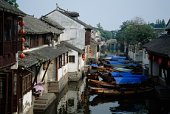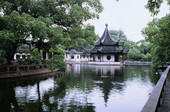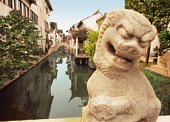Highlights:
• On this tour you will get to see one of the most beautiful and enchanting areas in all of China, and makes for a perfect getaway from some of the bigger Chinese cities. Suzhou is a city known throughout Asia for its beautiful canals, rivers, and heavenly gardens.
• On your tour you will visit the essential Suzhou attractions, such as the peaceful and beautiful Humble Adminstrator’s Garden and Tiger Hill. You will also have a cruise down the Grand Canal, and a garden show of traditional Suzhou culture and music.
• A professional English-speaking guide, who is also a native of the city, will accompany you on your tour. This will ensure that not only will your tour be stress-free, but it will also be highly informative and enjoyable.
(B=breakfast)
Day-by-day Detailed Itinerary:
Day 1 arrive in Suzhou
You will arrive at the Suzhou train station or airport, and when you arrive you’ll be met by your English-speaking guide. You’ll be taken to your hotel, and after you unpack we’ll get started on your touring in Suzhou. Suzhou is a city on the lower reaches of the Yangtze River and on the shores of Lake Taihu in the province of Jiangsu, China. The city is renowned for its beautiful stone bridges, pagodas, and meticulously designed gardens which have contributed to its status as a great tourist attraction. It is widely known as the “Chinese Venice”.
Our first stop today will be the Humble Administrator’s Garden. The garden is the best representative of Chinese classical gardens. Constructed in the Ming dynasty, the garden focuses on a central pond with pavilions, terraces, chambers, and towers located nearby, the garden is divided into three parts: the eastern, middle and western parts. Don't miss the Garden Museum - actually don't miss any of this lovely place. You should wear comfortable shoes, as there's a lot of walking here.
We’ll then go to another great example of the classical Chinese garden, the Lingering Garden. Liuyuan, or Lingering Garden, was first built in the Ming Dynasty (1368-1644) and was rebuilt by a Qing official. Its Taihu Lake rocks boost its reputation both at home and abroad. The core of the two-hectare garden is a pond, with hills to the northwest and buildings to the southeast responsible for a good many of the contrasting effects. The eastern section features mainly halls and courtyards. The imposing Wufengxian (Five-Peak immortals) Hall is the largest hall of all the Suzhou gardens. The western section is dotted with vegetation whereas the northern section is reminiscent of a peaceful countryside.
Afterwards we’ll take a pleasant cruise down Beijing-Hanghzou Grand Canal, which through Suzhou. First constructed at the end of Spring-Autumn Period, in the 5th century BC, the Grand Canal was extended in the 7th century, and again in the 13th century. It has played an important role in the development of water, conservancy and the economic and cultural exchange between the northern part and the southern part of China. Cruising the Canal in Suzhou you can view the daily life of the people living on the both sides of the canal as well.
We’ll then arrive at the Panmen City Gate, the oldest city gate in existence in Suzhou city. It used to be one of the eight city gates during the Spring & Autumn Annals (770-476 BC) when Suzhou was the capital of the Wu Kindom. The current gate was reconstructed in 1351. It consists of Water and Land Gates, city gate tower and city walls at both sides.
Suzhou is known throughout China for its refined culture of graceful music, performance, and its own brand of opera, much of which takes place in Suzhou’s gardens. You’ll be treated to a performance in one of Suzhou’s gardens, and then we’ll head back to the hotel for the night.
Day 2 Suzhou-departure (B)
After breakfast in the hotel, we’ll continue your sight seeing of Suzhou. We’ll first arrive at Tiger Hill, which in Chinese is known as Huqiu. The 36-meter-tall Huqiu (Tiger Hill) stands outside the lumen Gate to the north west of Suzhou. It was where the King of the State of Wu( a small state in the Spring and Autumn Periods over thousands of years ago) Fu Chai, buried his father-Helu along with 3,000 swords. Legend has it that on the third day after the burial, a white tiger appeared to guard the tomb, hence the name of the hill.
The Yunyan Temple, another key attraction on the hill, is one of the most famous Buddhist land in this part of China. Even Emperor Qianlong of the Qing Dynasty could not resist its peaceful ambience so he decided to make the temple his temporary residence during his Suzhou trip.
Before your departure, we will visit the Canglang Pavilion (Blue Wave Pavilion). It is one of the four most famous gardens of the city. Canglang Pavilion is the oldest of the Suzhou gardens that can be traced back to the Northern Song Dynasty (906-1127). During that part of history, a scholar Su Shunqing was demoted and sent to Suzhou. He bought the garden and built the pavilion in a setting adjacent to water that was on the property that would enhance the beauty of the garden. The garden was then named Canglang Pavilion in honor of his namesake, Canglang Wong.
You will then be taken to the Suzhou train station or airport, and you will go on to your next destination, ending your tour. A trip to Suzhou can also be easily combined with a trip to Shanghai and the World Expo. To find out more you can visit our Shanghai Expo page. |





